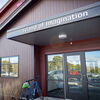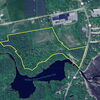
Processing Your Payment
Please do not leave this page until complete. This can take a few moments.
- News
-
Editions
View Digital Editions
Biweekly Issues
- November 17,2025
- November 03, 2025
- October 20, 2025
- October 6, 2025
- September 22, 2025
- September 8, 2025
- + More
Special Editions
- Lists
- Viewpoints
-
Our Events
Event Info
Award Honorees
- Calendar
- Biz Marketplace
The Maine Housing Crunch: The Green New Deal and Portland’s dilemma
 Photo / Jim Neuger
Developers Chris Rhoades (left) and Drew Preston on the roof of the Time & Temperature Building in Portland.
Photo / Jim Neuger
Developers Chris Rhoades (left) and Drew Preston on the roof of the Time & Temperature Building in Portland.
When local developers Chris Rhoades and Drew Preston proposed to the city of Portland a 275-unit apartment building, half of which would have been deemed affordable housing, they hoped to get help with funding through a TIF, or tax incremental financing, geared to such affordable housing projects.
The two developers, partners with the Presidium Group, says they had been in talks with the city for over a year on the estimated 200-foot high-rise with parking at 45 Brown St., making multiple accommodations and changes. But they still failed to get the TIF supported.
Without the special financing, the project became unaffordable and the developers are sitting on the land, which sits behind the Time & Temperature Building.
“Portland’s No. 1 mandate is housing and the priority is affordable housing, yet their actions say otherwise,” says Rhoades. “When presented with the biggest affordable housing development in the city that tried to use a TIF designated for such affordable housing projects, the city rejected it. It doesn’t make sense.”
The city of Portland says the project itself wasn’t rejected. The Housing and Economic Development Committee took no action on the Affordable Housing TIF and the project did not move forward, the city says.
Rhoades says the city needs to start authorizing the available TIFs or reverse the Green New Deal, which mandates that certain new residential construction in Portland meet affordability requirements.

The Green New Deal, passed by voters in 2020, requires that in developments of 10 or more units, 25% of those units must be affordable to people making 80% of the area median income. The previous rule required 10% of new units to be workforce units and defined workforce units as affordable for households that earn 100% of the area median income.
In 2020, prior to the new inclusionary zoning provision, 756 residential units were put on the planning books. A year later, only 139 units had been put on the books, a decrease of 81.6%, according to a study by the Boulos Co.
Kevin Kraft, deputy director of planning at urban development for the city of Portland, says it was too soon to determine the effects of the Green New Deal because some projects take years to plan. He says the city had a number of residential projects below the 10-unit threshold.
The Green New Deal referendum must remain as a law on the books for five years, at which point the city can vote and change it. Or another voter referendum can be passed that overrides the Green New Deal.
“There is no pipeline for multi-family development projects in Portland. It’s unfortunate. The Green New Deal effectively moved development outside the city,” says Jonathan Culley, managing partner with Redfern Properties in Portland.
Culley is developing an 81-unit project at 45 Forest Ave. that includes affordable housing units, but that project made economic sense due, in part, to historic tax credits.
“With the Green New Deal and inclusionary zoning, there will be no large-scale developments in Portland. It’s really unfortunate because we have a significant housing crisis,” Culley says.
Mainebiz web partners

The Giving Guide
The Giving Guide helps nonprofits have the opportunity to showcase and differentiate their organizations so that businesses better understand how they can contribute to a nonprofit’s mission and work.
Learn More
Work for ME
Work for ME is a workforce development tool to help Maine’s employers target Maine’s emerging workforce. Work for ME highlights each industry, its impact on Maine’s economy, the jobs available to entry-level workers, the training and education needed to get a career started.
Learn More
Groundbreaking Maine
Whether you’re a developer, financer, architect, or industry enthusiast, Groundbreaking Maine is crafted to be your go-to source for valuable insights in Maine’s real estate and construction community.
Learn more-
The Giving Guide
The Giving Guide helps nonprofits have the opportunity to showcase and differentiate their organizations so that businesses better understand how they can contribute to a nonprofit’s mission and work.
-
Work for ME
Work for ME is a workforce development tool to help Maine’s employers target Maine’s emerging workforce. Work for ME highlights each industry, its impact on Maine’s economy, the jobs available to entry-level workers, the training and education needed to get a career started.
-
Groundbreaking Maine
Whether you’re a developer, financer, architect, or industry enthusiast, Groundbreaking Maine is crafted to be your go-to source for valuable insights in Maine’s real estate and construction community.
ABOUT
NEW ENGLAND BUSINESS MEDIA SITES
No articles left
Get access now
In order to use this feature, we need some information from you. You can also login or register for a free account.
By clicking submit you are agreeing to our cookie usage and Privacy Policy
Already have an account? Login
Already have an account? Login
Want to create an account? Register
Get access now
In order to use this feature, we need some information from you. You can also login or register for a free account.
By clicking submit you are agreeing to our cookie usage and Privacy Policy
Already have an account? Login
Already have an account? Login
Want to create an account? Register







0 Comments